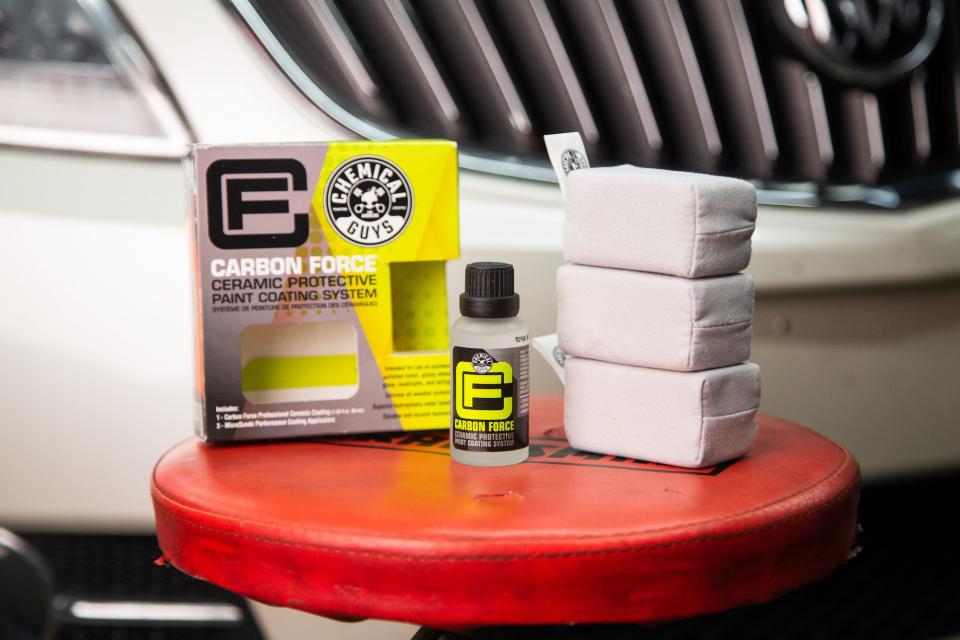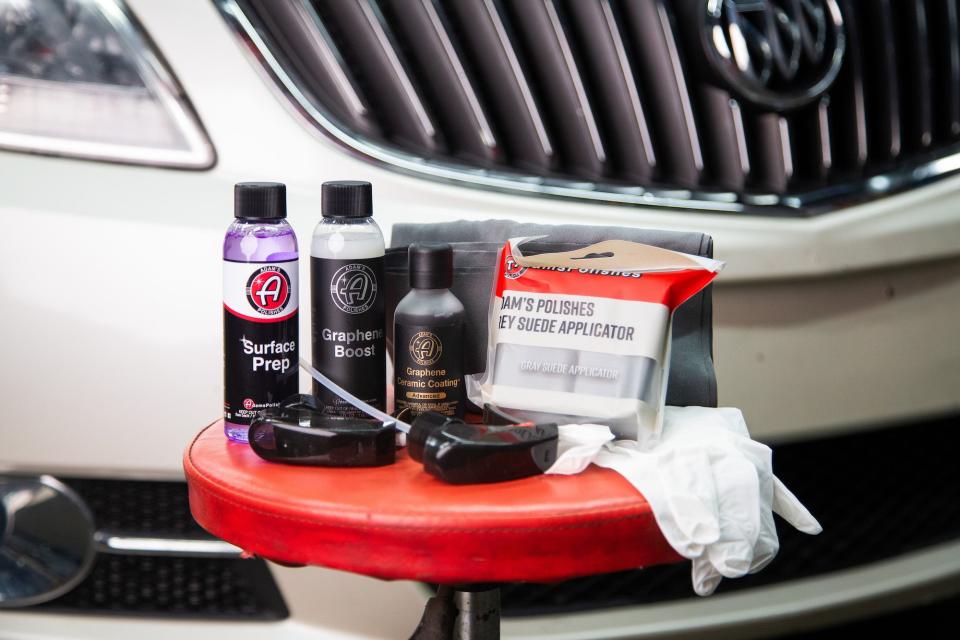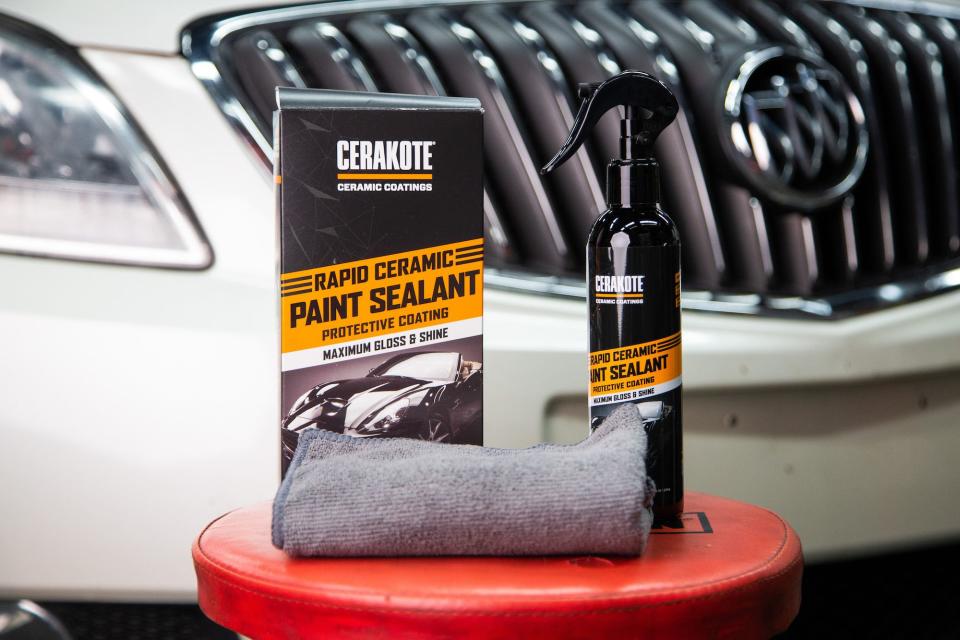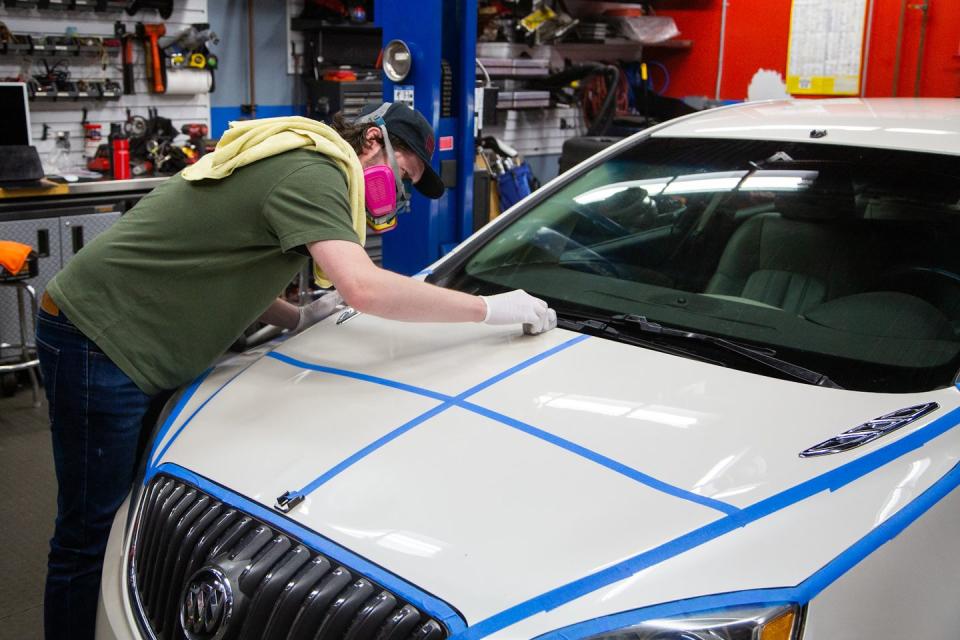To Coat or Not to Coat? Keep Your Car's Paint Pristine with the Best Ceramic Coatings

"Hearst Magazines and Yahoo may earn commission or revenue on some items through these links."
If you've searched for any car-cleaning product over the past few years, odds are you've come across the terms "ceramic technology" or "ceramic coating." But what exactly is a ceramic coating, and how can it help keep your car looking its best?
We're here to explain what ceramic coatings are and to test a few products on the market to see how they perform over a long period of time. To test not just the efficacy but the long-term durability of these ceramic coatings, we'll be updating this article regularly.
We'll start by evaluating our experience applying these products. We're also going to take a deep dive, in hopes of clearing up some confusion over what ceramic coatings are, what they aren't, and if you need one. It's worth reiterating that alongside each product below is simply a summary of our initial experience with it—not a complete review of its abilities. (Yet.) Stay tuned for updates.
Ready to dive in? Here's what you need to know before jumping into the daunting world of DIY ceramic coatings. (Spoiler alert: It's not that scary, as long as you know what you're getting yourself into.)
What Is a Ceramic Coating?
So, you've heard the term "ceramic," but what exactly is it, in the context of automotive applications? A ceramic coating is a liquid polymer applied to a car's exterior. Once applied, it creates a bond with the vehicle's factory paint, forming a layer of protection on top of your car's clear-coat to add an additional level of defense against the elements.
Ceramic coatings are primarily formulated of silicon dioxide (SiO2) but can also include other additives, such as titanium dioxide (TiO2), to increase their protective qualities and longevity. After you apply and properly cure the ceramic coating, the result is a tough protective layer that should keep everything from bird crap to brake dust at bay.
While this seems straightforward enough, car-cleaning chemical manufacturers have (both literally and metaphorically) diluted the effect of the term "ceramic." No two ceramic coating products are identical, and the key differentiator among all of them is the amount of SiO2 used.
Professional-grade ceramic coatings—the kind dealers apply before they deliver a car, or detail shops will apply for hundreds of dollars—are typically very concentrated (usually >80 percent SiO2) and come in very small bottles. There are other products on the market that have roughly the same chemicals but are far more diluted. These are also called ceramic coatings by their manufacturers. A diluted ceramic coating isn't necessarily inferior to more concentrated solutions, but it does, at least in theory, mean the coating won't last as long over time—an important detail that is at the heart of this very test.
See all the best deals on ceramic coatings for cars at amazon
Carbon Force
Chemical Guys' Carbon Force came in a compact package with the ceramic-coating liquid, three application pads, and instructions on the back of the box. Of all the ceramic coatings we tested, it was the most viscous, having an almost gel-like consistency.
The coating went on smooth and even, evaporated within three to four minutes, and wiped off clean with a microfiber towel, leaving behind an even coat with no visible hazing. After roughly 24 hours to cure, the Carbon Force had the thickest coating compared to its competitors. It was notably thick, with an almost tacky texture, but it smoothed out over the coming days.

Carbon Force
$139.99
amazon.com
Gannon Burgett - Car and DriverGraphene Ceramic Coating Advanced
Adam's Polishes' Graphene Ceramic Coating Advanced, much like Carbon Force, is a concentrated mixture with a syrup-like consistency. In addition to a pair of gloves, a large microfiber towel, and two applicators, the Standard Kit also comes with a surface-prep liquid to apply and wipe off before application, as well as a Graphene Boost spray for keeping the ceramic coating looking its best after it's cured. (We definitely recommend buying the kit; it has everything you need.)
The ceramic coating itself went on smoothly with the included applicators and dried within three to four minutes. After initial evaporation, it wiped off dry. After it cured, we felt the surface of the coating and noticed it, too, had a slightly grippy feel compared to our coating-free control area. It also came out less dense than the Chemical Guys' Carbon Force but still dramatically thicker than the two hybrid sprays that follow.

Graphene Ceramic Coating Advanced
$117.03
amazon.com
Gannon Burgett - Car and DriverGraphene Ceramic Spray Coating Advanced
Adam's Polishes' Graphene Ceramic Spray Coating Advanced might be similar in name to its more concentrated counterpart, but it comes in a much larger spray bottle and doesn't require dedicated applicators. Instead, you apply it with a small microfiber cloth or pad (we used the latter).
It's a noticeably thinner liquid and goes on much lighter than the two concentrated ceramic coatings. It dries within one to two minutes and wipes off cleanly. It had the same 24-hour curing time as the other coatings and came out with a smooth finish. The texture wasn't as tacky as the concentrated ceramic coatings, but it was obvious there was some kind of coating compared to the control area of the hood.

Graphene Ceramic Spray Coating Advanced
$43.99
amazon.com
Gannon Burgett - Car and DriverRapid Ceramic Paint Sealant
Cerakote's Rapid Ceramic Paint Sealant is about as cheap and simple as you can get in the world of ceramic coatings. It comes with a spray bottle and microfiber cloth and is easily the most watery of the bunch—a hint that it likely doesn't have nearly as much SiO2 as the other coatings we tested.
We used a microfiber pad to apply the Cerakote. It dried within a minute and wiped off more like a standard protective spray than the other ceramic coatings we tested. After its 24-hour cure, the area of the hood with the Cerakote was ever so slightly different in texture compared with the control area of the hood—but there was a difference. When running a fingernail gently across the coatings, it's clear this is the thinnest of the bunch. Whether that is a determining factor in its effectiveness remains to be seen, but we'll let you know when we check back in a few months.

Rapid Ceramic Paint Sealant
$19.95
amazon.com
Gannon Burgett - Car and DriverShould You Ceramic-Coat Your Car?
As with so many questions in the world of DIY, it depends. Whether you should apply a ceramic coating to your car depends on your confidence level, patience level, precision, and the space and tools you have available. After doing a few ceramic coatings ourselves, we feel confident in saying that applying a DIY ceramic coating isn't as arduous a task as it appears. Yes, it's time-consuming. And yes, it's semi-permanent; should something go wrong, you're stuck with the results for a while. But as long as you properly prepare your vehicle, have the patience to follow all instructions, and let the coating properly cure, you should have a quality coating ready to protect your vehicle for months or even years to come.
This brings us to the most important part: The keys to success with ceramic coatings are careful preparation and meticulous cleanliness. You will also want to wear and use personal protective equipment (PPE), including a respirator and gloves.
Starting with a Clean Slate
Having a perfectly clean car is the most critical component of getting the best finish possible with a ceramic coating—and we're not just talking about running your ride through a car wash. Ceramic coatings bond to your paint and create a protective barrier over every atom of your vehicle's exposed surfaces, and high-quality, professional coatings can last upward of five to eight years. Any small imperfection, from small bits of embedded brake dust to a stray leg of an unlucky fly, could be sealed into your vehicle's paint job for years.
Give the entire exterior of your car the most extensive detail job it's ever had. This includes any paint corrections you want to make, a thorough hand wash, a clay bar session, a buff job as you see fit, and a final wipe of a microfiber cloth to remove every bit of dirt and debris from the clear-coat.

How We Tested and Initial Findings
How we tested
For our testing, we used two highly concentrated ceramic coatings: Adam's Polishes' Graphene Ceramic Coating Advanced and Chemical Guys' Carbon Force Ceramic Coating. We also used two hybrid ceramic coatings with lower concentrations of SiO2: Adam's Polishes' Graphene Ceramic Spray Coating Advanced and Cerakote's Rapid Ceramic Paint Sealant. Our vehicle of choice was a 2012 Buick Verano, a trusty steed that, while not new, should serve as a reliable ride for testing the long-term performance of each of these products.
To test, we split the hood into six sections: one for each ceramic coating product, divided into roughly equal quadrants on the top of the hood, as well as two slivers on the side serving as our non-coated control sections. We carefully applied each coating as instructed on the directions of each product in the Car and Driver garage, using proper safety measures, including personal protective equipment and ventilation. After proper application, the coatings were given roughly 24 hours to cure, per the manufacturers' recommendations.
Initial findings
The application process is only the beginning of this long-term review, but we've already learned a few important details about each product we tested. First and foremost is the difference in how you apply the highly concentrated ceramic coatings as opposed to the hybrid ceramic coatings.
The more concentrated solutions are applied by dripping the solution onto included applicators, rubbing the solution into the applicator, and carefully running those applicators across the vehicle's surface in a cross-hatch pattern (first up/down across the surface, then left/right across the surface). These concentrated solutions were quite viscous and had an almost gel-like consistency to them.
By comparison, the hybrid ceramic coatings are applied to either a microfiber cloth or pad and then wiped over the surface of a vehicle using the same cross-hatch pattern. These coatings were much less viscous and applying them to the microfiber pads was less precise than the concentrated bottles due to the use of a spray nozzle.
All in all though, the solutions went on without a hitch and were ready to wipe off within minutes. We then left the vehicle in the Car and Driver garage overnight to cure before exposing it to the elements.

FAQs
What is a ceramic coating?
A ceramic coating is a liquid polymer that is applied by hand to the exterior of a vehicle. The coating chemically bonds with the vehicle's factory paint, creating a layer of protection.
What are the benefits of ceramic coating?
Ceramic coatings offer a better level of protection against environmental hazards and damage from the sun's UV rays than traditional wax. They also offer resistance to chemical stains and a certain degree of scratch resistance, giving the car a high-gloss finish and making it easier to clean.
Can I use ceramic coating on matte or satin finishes?
Yes, nearly all ceramic coatings should work on matte or satin finishes. Do note that the paint or wrap could slightly change in look a bit, but it should still maintain the original matte or satin look with the added protection. However, to confirm whether or not it's the look you're going for, we suggest testing out the coating on a small section of the vehicle first, preferably in an area not easily visible.
Does a ceramic coating prevent scratches?
A ceramic coating does provide a certain level of resistance to minor scratches. However, it's not bulletproof, and severe scratches can still penetrate the coating and damage the paint.
How long does a ceramic coating last?
With proper maintenance, a high-quality ceramic coating product can last for several years. The exact lifespan will depend on various factors like the quality of the product, the preparation and application process, and how the vehicle is maintained.
Can I apply a ceramic coating myself?
Yes. However, as explained above, the process requires an extensive amount of preparation, including thorough cleaning and possibly paint correction. So be prepared to make the fiscal and time commitment to do the job right.
Does ceramic coating require maintenance?
Strictly speaking, the coating itself doesn't necessarily require any additional maintenance than a car without a ceramic coating.
What is the difference between ceramic coating and wax?
Ceramic coatings offer longer and more durable protection than wax. Wax usually lasts a few months at most, while a ceramic coating can last for years. Additionally, ceramic coatings offer superior resistance to UV rays, chemical stains, and water spots.
Does ceramic coating protect against rock chips?
While ceramic coatings provide some resistance against minor scratches and chemical etching, they don't provide full protection against rock chips or similar damage.
Can I remove a ceramic coating?
Ceramic coatings are semi-permanent, so they aren't easily removed. The process typically involves abrasion, like wet sanding or using a machine polisher. This should be done by a professional to avoid damaging the paint if you need to remove the coating.
Why Trust Us
Hearst Autos combines the talent, resources, and expertise of three of the largest, most influential automotive publications in the world. The Gear Team has tested a wide variety of automotive products, parts, accessories, and gear, such as GPS trackers for cars, OBD2 scanners, and electric car chargers. We get our hands on each and every product we test. Most are purchased; manufacturers supply some.
Hearst Autos doesn't need to game algorithms for traffic or promote lousy products to earn a buck. Instead, we're more concerned with our legacy, our reputation, and the trust our readers have in Autoweek, Car and Driver, and Road & Track to deliver honest opinions and expert evaluations.
Visit our Tested & Trusted page to see the very best in automotive gear. Read more about our product testing and evaluation process here.


